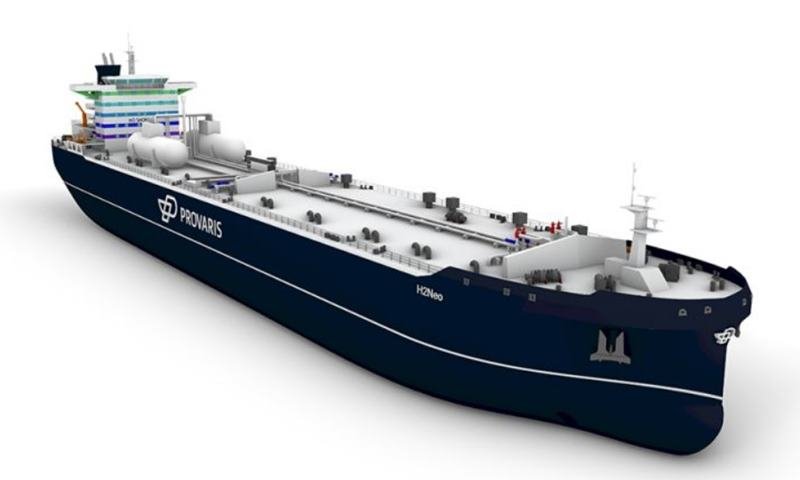Provaris Energy Ltd. is pleased to advise that the American Bureau of Shipping (ABS), has reviewed, verified, and approved the design of the 26,000m3 H2Neo compressed H2 carrier (H2Neo). This critical milestone approval follows the completion of extensive Front End Engineering Design (FEED) work and ABS review activities. It confirms that our innovative and cost-effective multi-layered hydrogen tank can be incorporated into our H2Neo Carrier and meets the requirements for Ship Classification.
The next steps in our journey to world-scale hydrogen shipping are to construct and test a prototype hydrogen tank, and to prepare for ship construction with a selected shipyard(s).
ABS is one of the largest and most respected Classification Societies that are focused on ship safety and excellence in design and construction.
Provaris Chief Technical Executive Officer, Per Roed comments: “The success of our FEED design stage and corresponding approval milestone is the result of extensive design and engineering works by Provaris’ team of discipline experts and consultants that have actively contributed to the development of Provaris’ innovative H2Neo hydrogen carrier. Through our close collaboration with ABS throughout this three-year process, we are confident that our compressed hydrogen carriers can safely and effectively establish the maritime transportation of hydrogen at a time when storage and transport remain key to unlocking markets with ambitions for hydrogen imports at scale from 2026.”
ABS Senior Vice President – Global Engineering and Technology, Patrick Ryan commented: “ABS recognizes the potential that hydrogen shows in supporting a sustainable, lower carbon future. Safe and efficient storage and transportation of hydrogen at sea will be critical to the development and viability of the global hydrogen value chain. We have been working closely with Provaris, initially granting AIP in 2021 and subsequently reviewing their comprehensive FEED level package for the H2Neo.
ABS is pleased to award Provaris approval of their design, and we look forward to continuing this relationship into continued testing and construction stages of H2Neo carriers, including a yard selection process, and to support Provaris during ship operations on the numerous, interesting projects on the H2 horizon.”
Provaris Managing Director & Chief Executive Officer, Martin Carolan added: “Compressed H2 can deliver a safe, economic and energy-efficient hydrogen shipping and transport solution that is essential to meet the climate targets for 2030 and beyond. Provaris has set itself ambitious targets for the detailed engineering and approvals required to develop the H2Neo carrier, and I am pleased to say our team has delivered on time and under budget a unique approach to marine hydrogen transport that is also a world first.
Our marketing program over 2022 continues to raise the awareness of compressed H2 as a first mover and feasible alternative for regional hydrogen trades. We expect this approval milestone to assist with the validation requirements in our commercialisation pipeline, transition Provaris to construction award status in 2023, and de-risk the development and approvals pathway for our large-scale H2Max carrier and our design for hydrogen storage barges.”
Table of Contents
Class Approval milestone follows the completion of extensive FEED and critical safety studies
In October 2020, Provaris launched an ambitious program to develop a compressed H2 carrier, and in 2021 ABS awarded Provaris with an Approval in Principle (AiP) for two classes of green compressed hydrogen (GH2) carriers, namely the H2Neo (26,000m3) and the H2Max (120,000m3 capacity). Provaris is taking the H2Neo through to construction-ready status in 2023, with the H2Max to follow 2026.
Provaris has spent 12 months completing this extensive FEED level design package for the H2Neo. This work program has been delivered on-time and on-budget, which has culminated in the receipt of a Design Approval from ABS, that confirms:
- The ship design is verified as capable of transporting compressed hydrogen at bulk scale at 250 bar pressure;
- The FEED package is sufficient for shipbuilders to quote (price and schedule) with confidence; and
- Critical safety studies, process and risk analyses have been carried out, which allowed ABS to verify relevant safety aspects of the ship’s design and operation.
ABS Consulting has carried out risk and safety workshops (HAZID) and specialist studies concerning gas dispersion, explosion and fire analysis to help assess and mitigate the risks associated with the storage and transportation of hydrogen. This is the first time that an extensive HAZID and FEED level design for a novel hydrogen carrier has been concluded.
Provaris will continue to work with ABS throughout the next phases of detailed production design, cargo tank testing and construction, and will continue to update shareholders on key milestones. This program will also include the appointment of a preferred shipyard for the final design and the construction of a prototype for testing during 2023.
Appointment of Clarksons for Shipyard Selection
Together with the receipt of ABS Design Approval for the H2Neo, Provaris is delighted to confirm the appointment of Clarksons’ newbuild team in London to work with Provaris to undertake a shipyard selection and tender process as we move towards the order of a fleet of H2Neo carriers.
Clarksons Managing Director S& P, Phil Harding commented: “We are delighted to continue our relationship with Provaris, and we look forward to working together to ensure we select the right shipbuilding partner(s) for these vessels. We welcome the opportunity to really make great strides in the green transition and are committed to working together to achieve this goal of a better ship, a greener future and aiming to be on the right side of history”.
Proprietary design and integration of the compressed H2 cargo tanks
The H2Neo design is characterized by two large-diameter cylindrical tanks, one in each of the port and starboard cargo holds with a maximum allowable operating pressure (MAOP) of 250 bar.
To avoid boil-off / cargo losses and to avoid the need for insulation and energy-intensive cooling during the voyage, the hydrogen is carried at ambient conditions. At these conditions, the design pressure rating of the cargo containment system has been determined to be 250 bar.
The advantage of the patented design, and Provaris’ Intellectual Property, is evident in the ABS-approved solution of integrating a relatively thick steel layered tank (as required for 250 bar) into the hull of a relatively conventional ship- sized hull with low operating drafts. Leveraging its experience with gas and compression, Provaris has assessed various compressed cargo containment solution options, duly taking into account the characteristics of hydrogen, including MAOP and temperature levels, and hydrogen embrittlement. These key parameters were considered in detail concerning safety, construction methodology / CAPEX and operations / OPEX.
The tanks are designed so that they cannot suddenly rupture and release a catastrophic amount of energy. This is achieved by a cargo tank construction that is composed of layers of steel, nested together, including a stainless-steel inner layer to protect the high-strength carbon steel from hydrogen embrittlement. This nesting ensures that sudden through-wall cracks are impossible. Moreover, the layered tank construction benefits the construction methodology of the cargo tanks.
Additional safety measures are applied through continuous monitoring of the cargo tanks integrity. By using components and software that are proven, and readily available, in the market, Provaris has developed a monitoring system that will be installed on the outermost layer of the cargo tanks.
Compressed H2 to provide first mover advantage for regional trade of hydrogen
Compression provides a simple and energy-efficient supply chain for green hydrogen. To facilitate maritime storage and transportation of compressed hydrogen, Provaris has developed the H2Neo and H2Max designs with a proprietary
cargo containment system that allows for hydrogen to be safely managed and stored at 250 bar pressure and ambient temperatures.
The loading of compressed hydrogen directly into the GH2 Carriers can be accomplished through existing, proven technology (compressors) eliminating the need for onshore hydrogen storage and/or facilities to convert the hydrogen into alternative forms at the loading port such as ammonia or liquefied H2. Similarly, the hydrogen will be delivered to customers directly through simple decompression from the ship’s cargo tanks, largely utilizing the energy stored in the cargo tanks, and there will be no need for facilities at the receiving terminal to store and/or crack, change, or regas the cargo before distribution.
Roadmap to low-emission shipping through electric propulsion
The H2Neo design is a result of extensive hull optimization and assessments of new technologies that have been applied to reduce fuel consumption. The propulsion platform is electric, including batteries for a hybrid configuration that allows for further fuel savings. The battery plant is scalable and allows for an effective integration of both existing and prime mover technologies under development (including alternative fuel engines and fuel cells) thereby allowing for future maritime operations without any greenhouse gas emissions.
H2Neo de-risks development pathway for the H2Max to support large-scale hydrogen supply required for 2030
Provaris development program for its unique compressed H2 carriers includes two carriers with different capacities, the H2Neo (26,000m3) and the H2Max (120,000m3), which have been designed to align with the development of both product supply and offtake for regional trade of hydrogen.
The H2Neo aligns with regional volumes of H2 supply to be available from 2026 and the H2Max, targeted for 2030, can support a single export project with a significant capacity of 950,000 tonnes pa. Provaris is also now extending the compressed H2 ship designs to develop floating storage barge solutions to store similar volumes.
The H2Max, with Class AIP received in 2021, will leverage the FEED design, hazid and approvals work completed for the H2Neo. Provaris anticipates the H2Max can provide a material improvement on delivery costs given the benefits of scale and also benefit from the availability of proven low-emission propulsion solutions.
| H2Neo | H2Max | |
| Cargo Carrying Capacity | 26,000 m3 at 250 bar | 120,000 m3 at 250 bar |
| Development Timeline | AiP Received 2021Design Approval (FEED) 2022Effective Shipbuilding Contracts 2023 (scheduled)First operations 2026 (target) | AiP Received 2021Design Approval (FEED) 2023 (scheduled)Effective Shipbuilding Contracts 2026 (target)First operations 2030 (target) |
| Project Export Capacity ** | 200,000 tonnes pa | 950,000 tonnes pa |
| Shipping Range | Up to 2,000 nautical miles | Up to 3,000 nautical miles |
The flexibility and added advantage of the compressed H2 design is that carrier volumes can be multiples of production capacity, with the selection of the carrier made according to the shipping distance and hydrogen volumes.
Media & Press Release Provaris Energy

